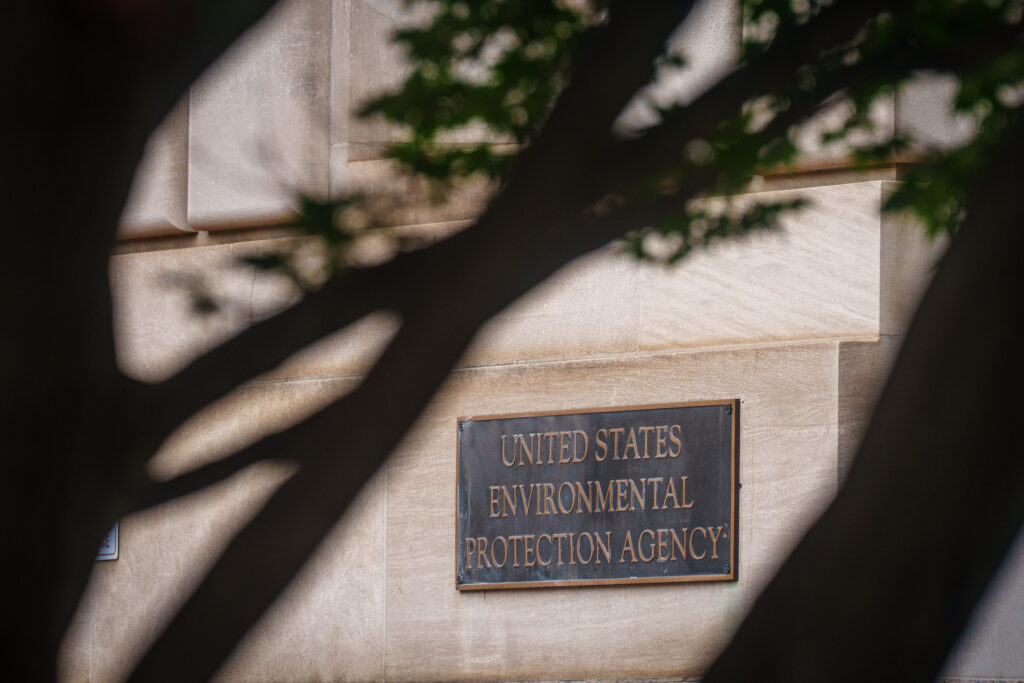
Since January, the Trump administration has laid off thousands of scientists and staff and cut research funding for those who remain across the federal government. At the same time, department heads at different agencies—from the U.S. Environmental Protection Agency to the National Oceanic and Atmospheric Administration—directed scientists to halt much of the research on climate change and its ripple effects on U.S. residents, lands and seas.
This summer, staff members from at least two agencies were put on leave after speaking out against these moves. Some were subsequently fired.
Paired with those aggressive pullbacks in federal funding for research, the administration has cultivated a widespread fear of retribution in the U.S. scientific community, one that jeopardizes free speech, experts say.
But many are still speaking up, albeit anonymously.
According to a recent survey, one sentiment rings true for a vast number of environmental researchers: Trump-era changes have had an “extremely negative impact” or done “irreparable harm” on their fields.
Critic Retaliation: At the end of June, hundreds of current and former EPA employees signed onto a public “Declaration of Dissent” opposing many of the Trump administration’s policies, which they said “undermine the EPA mission of protecting human health and the environment.”
The petition made some strong accusations, calling out the administration for subverting public trust, reversing progress made to help improve the lives of “America’s most vulnerable communities” and “ignoring scientific consensus to benefit polluters,” particularly surrounding asbestos, mercury and greenhouse gases.
Just days after the petition was released, 139 employees who signed it were put on leave, my colleagues Lisa Sorg and Aman Azhar reported in July.
“These are trumped-up charges against EPA employees because they made a political statement the Trump administration did not like,” Nicole Cantello told my colleagues. She is president of the American Federation of Government Employees (AFGE) Union Local 704 and leader of AFGE Council 238, which represents over 8,000 EPA employees. “Now the Trump administration is retaliating against them.”
Since then, at least eight employees who signed the letter have been terminated, according to The Associated Press. I asked the EPA how many had been fired and a spokesperson said in an email that the agency “does not comment on individual personnel matters,” but that the decisions were made following a “thorough internal investigation.”
“The petition—signed by employees using a combination of their titles and offices—contains inaccurate information designed to mislead the public about agency business,” the spokesperson said in an email. “Thankfully, this represents a small fraction of the thousands of hard-working, dedicated EPA employees who are not trying to mislead and scare the American public.”
In August, a similar situation occurred at the Federal Emergency Management Agency. A group of 36 FEMA employees were put on administrative leave after signing a letter accusing President Donald Trump and Homeland Security Secretary Kristi Noem, whose department oversees FEMA, of hamstringing the agency’s ability to perform its lifesaving missions by cutting programs and staff, appointing an underqualified administrator and censoring climate science. The letter was published just a few days before the 20th anniversary of Hurricane Katrina, and was aimed at avoiding a similar catastrophe in disaster management, the authors wrote.
FEMA did not say whether the employees put on leave would be terminated.
“It is not surprising that some of the same bureaucrats who presided over decades of inefficiency are now objecting to reform,” a Department of Homeland Security spokesperson wrote in an email to Inside Climate News. “Change is always hard. It is especially for those invested in the status quo. But our obligation is to survivors, not to protecting broken systems.”
Earlier, Trump said he intended to eliminate FEMA, possibly by the end of this year. Then deadly flooding tore through Texas’ Hill Country, and few survivors could get through to FEMA because Noem’s agency had stopped paying for an aid hotline, NPR reported in August.
Soon after the disaster, Noem was saying that Trump merely wants to remake FEMA, not scrap it.
Growing Uncertainty: Fearing retribution, many federal workers and researchers who rely on federal funding have not stepped forward publicly to express their concerns about how policies impact their work. But a survey compiled by the American Society of Naturalists gives insight into how scientists are faring under Trump—and it’s not looking good.
Sent from early June through mid-July to 14 scientific societies, including the Wildlife Society and Society of Systematic Biologists, the survey asked a range of questions on how federal policies have impacted participants since Trump was inaugurated. Participants, who shared their thoughts anonymously, included scientists from every state and a variety of career stages spread across academia, the federal government, nonprofits and industry.
More than 80 percent of respondents said that federal policies had a detrimental impact on their work, and a majority reported a negative effect on their personal lives. Around half of the respondents reported they had experienced a “chilling effect on free speech.” One of the overarching takeaways was also an uncertainty for the future, with scientists expressing concern for the next generation of researchers as funding cuts inhibit training programs and a lab’s ability to hire more early-career staff.
Just 2 percent of the respondents were in support of the administration’s changes.
“The cancellation of funding and the removal of solicitations has had a massive impact on my ability to function as [a] conservation biologist and my ability to plan for the future,” one anonymous participant wrote. “Scientists from federal and state and local agencies rely on me and my lab to provide analytical services and expertise to aid with on-going endangered species conservation efforts.”
I asked the White House what their thoughts were on this survey and what respondents say have been restrictions on free speech.
“The United States is the largest funder of scientific research and is home to the largest public-private ecosystem for innovation in the world,” White House spokesman Kush Desai said in an email. “The Trump administration’s commonsense efforts to realign grant funding away from ideological pet projects and streamline our bloated government are further strengthening America’s scientific dominance.”
As journalists, my colleagues and I are dedicated to covering how government actions impact climate change and efforts to mitigate it. But it’s been unusually difficult this year to connect with sources willing to speak publicly about how Trump administration decisions are affecting them.
Heatmap’s Jeva Lange summed it up in her February article, “The Great Clamming Up.”
“Some might be worried about what will happen if they stick their necks out and are playing a sort of wait-and-see game with everyone else; others, justifiably, might be scared of more direct forms of retribution,” she wrote. “This makes it challenging to report stories, of course. But it’s also, more existentially, a crisis of democracy.”
As a result of this, you readers may have noticed more news articles than usual with anonymous sources. When you see this type of source in an article at Inside Climate News, it means the reporters and editors involved have both vetted who this person is and concluded that there is a valid reason for leaving out their name, such as a risk to their safety or livelihood (which can be possible, as the situations at FEMA and EPA have made clear).
If you would like to share how recent federal policies have affected your work, please feel free to reach out to any of our reporters. That includes myself—you can reach me at [email protected] or kileyjprice.79 on Signal.
More Top Climate News
Earlier this month, Florida’s surgeon general announced that the state would start the process of allowing people to opt out of vaccine mandates for “personal health benefits.” Public health experts are concerned that a combination of stronger hurricane seasons and an unvaccinated population could pose higher health risks in the area, Ariel Wittenberg reports for E&E News.
Research shows that a hurricane and its aftermath can increase the risk of mosquito-borne illnesses such as dengue fever because the insects breed in standing water. Tropical storms have also been linked to a spike in respiratory illnesses, cholera and E. coli. Groups of people huddling in storm shelters can also spread disease, particularly if individuals don’t have vaccines to protect themselves.
Researchers found that much of the shark meat available on seafood shelves in the United States is from endangered species, Marina Dunbar reports for The Guardian. Scientists from the University of North Carolina at Chapel Hill tested the DNA of 29 shark-meat products from grocery stores, seafood markets and online vendors, several of which turned out to be from imperiled species, such as great hammerhead and scalloped hammerhead sharks. More than 90 percent of the products were mislabeled or only used a vague description that would not allow consumers to know what was inside, according to the study.
As summers get hotter around the world with climate change, governments are enacting more laws to protect workers from sizzling temperatures, but experts say these efforts aren’t happening fast enough, Somini Sengupta and Hisako Ueno report for The New York Times. In Europe, several countries ordered a pause on outdoor afternoon work this summer for several weeks, while Singapore has beefed up its requirements for heat and humidity tracking at work sites. With an estimated 2.4 billion people exposed to heat stress at work, many experts say these steps don’t go far enough. Meanwhile, the U.S. government is still fighting over a draft rule to prevent heat-related illness for workers, as my colleague Liza Gross reported.
Postcard From … Alaska
For this installment of “Postcards From,” Keerti Gopal, our climate and health reporter, sent in photos she took during a recent trip to Alaska. She snapped these images in July while hiking Exit Glacier in Kenai Fjords National Park to get to the Harding Icefield Trail.
“It’s a jaw-droppingly beautiful hike that takes you about 3,400 feet up from dense green forests into the sprawling icefield, where you’re surrounded by icy, snow-covered peaks,” Gopal told me.
On a more somber note, she said the glacier was a stark reminder of how fast Alaska is warming. The top photo was taken from the 2010 marker, showing how far the glacier has retreated in just 15 years.
“Exit Glacier is a pretty iconic visible marker of climate change because it’s retreating rapidly,” she said. “As you walk toward the glacier, you’ll pass by signs marking years, beginning in 1917, that show you where the end point of the glacier used to be. I think and write about climate change all the time, but walking that trail felt like such a uniquely visceral experience, and a stark depiction of how much the landscape has changed in my own lifetime.”



